Typical Fault Modeling and Vibration Characteristics of the Turbocharger Rotor System
Abstract
1. Introduction
2. Theoretical Method
2.1. Dynamics Model of a Rotor-Bearing System
2.2. Rotor System Typical Failure Modeling
- (i)
- Rotor imbalance
- (ii)
- Rotor bumper modeling
- (iii)
- Rotor crack modeling
2.3. Hu Invariant Moment Feature Extraction
3. Calculation Conditions and Model Validation
3.1. Rotor System Model Parameters
3.2. Model Validation
4. Calculation Results and Analysis
4.1. Rotor Unbalanced Fault Characterization
4.2. Characterization of Rotor Bumper Fault
4.3. Rotor Cracking Fault Characterization
5. Conclusions
- (1)
- Compared with the traditional set total parameter method, the improved four-node centralized parameter method overcame the limitation of calculating a large number of axis segments and effectively reduced the calculation volume and calculation time. By comparing the critical speed calculation results of FEM and TMM, the errors were found to be less than 3%, which proves the reliability of the model established in this paper.
- (2)
- When the unbalance fault occurred in the rotor system, the displacement time domain waveform approximated a sine wave, and the rotor axis trajectory was “0” shaped. In the steady state of operation, the rotor exhibited single-cycle motion, and its response spectrum was dominated by 1X.
- (3)
- When the rotor system had a friction fault, the displacement time domain waveform was similar to a sine wave, and the rotor axis trajectory was a slightly concave “8” shape, with 0.5X dominating the frequency spectrum. When the friction fault was light, the rotor system entered a two-cycle motion. When the friction fault was more serious, the rotor system entered the proposed cycle motion.
- (4)
- When a crack fault occurred near the impeller journal, the displacement time domain waveform was distorted and the rotor axis trajectory was “vortex” shaped, and the response spectrum was dominated by 0.5X, which was mainly caused by the oil film vortex. At the same time, the crack failure also caused a significant vibration peak at the 1.5X harmonic. The combined effect put the rotor system in a proposed periodic motion.
Author Contributions
Funding
Data Availability Statement
Conflicts of Interest
Nomenclature
| X | The displacements of the wheel along the x directions |
| Y | The displacements of the wheel along the y directions |
| Φ | The angles of rotation of the wheel in the x-axis directions |
| Ψ | The angles of rotation of the wheel in the y-axis directions |
| m | The mass of the wheel |
| Jdi | The diameter inertia |
| Jpi | The pole inertia |
| E | The modulus of elasticity |
| I | The moment of inertia of the section |
| l | The length of the shaft section |
| wr | The rotor speed |
| e | The distance between the centers of the wheel |
| t | Time |
| F | Force |
| M | The bending moment |
| The cross-sectional moment of the shaft section | |
| The shear factor, | |
| The cross-sectional coefficient (0.886 for solid circular shafts and about 2/3 for thin-walled hollow shafts) | |
| The vector of degrees of freedom of the rotor | |
| The mass matrix of the rotor | |
| The rotor stiffness matrix | |
| The gyro matrix | |
| The excitation force vector | |
| The total mass at the impeller of the compressor | |
| The total mass at the bearing near the impeller | |
| The total mass at the bearing near the turbine | |
| The total mass at the turbine | |
| Damping at the compressor impeller | |
| Damping near the impeller bearing | |
| Damping near the turbine bearing | |
| Damping at the turbine | |
| The bending stiffness of the shaft segment | |
| The eccentric mass at the impeller | |
| The eccentricity at the turbine of the compressor | |
| The component of the oil film force in the x-direction | |
| The component of the oil film force in the y-direction | |
| The distance between the rotor and stator of the supercharger | |
| FEM | Finite element method |
| TMM | Riccati transfer matrix method |
References
- Horner, G.C.; Pilkey, W.D. The Riccati Transfer Matrix Method. J. Mech. Des. 1978, 100, 297–302. [Google Scholar] [CrossRef]
- Ngo, V.T.; Xie, D.; Xiong, Y.; Zhang, H.; Yang, Y. Dynamic analysis of a rig shafting vibration based on finite element. Front. Mech. Eng. 2013, 8, 244–251. [Google Scholar] [CrossRef]
- Singh, A.; Gupta, T.C. Effect of rotating unbalance and engine excitations on the nonlinear dynamic response of turbocharger flexible rotor system supported on floating ring bearings. Arch. Appl. Mech. 2020, 90, 1117–1134. [Google Scholar] [CrossRef]
- Phadatare, H.P.; Pratiher, B. Dynamic stability and bifurcation phenomena of an axially loaded flexible shaft-disk system supported by flexible bearing. Proc. Inst. Mech. Eng. Part C J. Mech. Eng. Sci. 2020, 234, 2951–2967. [Google Scholar] [CrossRef]
- Fu, C.; Xu, Y.; Yang, Y.; Lu, K.; Gu, F.; Ball, A. Response analysis of an accelerating unbalanced rotating system with both random and interval variables. J. Sound Vib. 2020, 466, 115047. [Google Scholar] [CrossRef]
- Guangchi, Y. Fundamental Excitation Identification and Rotor Dynamics of Turbocharger. Ph.D. Thesis, Shanghai Jiaotong University, Shanghai, China, 2008. [Google Scholar]
- Zhang, Y.; Wang, W.; Yao, J. Analysis of axial-radial friction nonlinear dynamics of a double-disk rotor system. Vib. Shock 2012, 31, 141–145. [Google Scholar]
- Liu, G.; Yu, Y.; Ma, X.; Haijuan, D.; Ding, H.; Wen, B. Nonlinear analysis of bumper rotor under the influence of mass eccentricity. Chin. J. Constr. Mach. 2016, 14, 21–25+31. [Google Scholar]
- Ghozlane, M. Dynamic Response of Cracked Shaft in Rotor Bearing-Disk System. Lect. Notes Control. Inf. Sci. 2015, 789, 615–624. [Google Scholar]
- Jain, A.K.; Rastogi, V.; Agrawal, A.K. Experimental Investigation of Vibration Analysis of Multi-Crack Rotor Shaft. Procedia Eng. 2016, 144, 1451–1458. [Google Scholar] [CrossRef]
- Khorrami, H.; Rakheja, S.; Sedaghati, R. Vibration behavior of a two-crack shaft in a rotor disc-bearing system. Mech. Mach. Theory 2017, 113, 67–84. [Google Scholar] [CrossRef]
- Xiuqin, W.; Hongyang, X. Improvement of invariant moment algorithm and human ear recognition technology. J. Heilongjiang Inst. Sci. Technol. 2008, 1, 51–53+57. [Google Scholar]
- Yue, Y.; Hong, W.; Peixin, Y.; Chang, W. An improved Hu-invariant moment algorithm for storage media image recognition. J. Instrum. 2016, 37, 1042–1048. [Google Scholar]
- Ding, Y.; Wu, J.J.; Jiang, Y.; Jiexian, Z. Fast image matching algorithm based on improved HU invariant moments. Sens. Microsyst. 2020, 39, 124–127. [Google Scholar]
- Ren, Y.; Yang, J.; Zhang, Q.; Guo, Z. Ship recognition based on Hu invariant moments and convolutional neural network for video surveillance. Multimed. Tools Appl. 2020, 80, 1343–1373. [Google Scholar] [CrossRef]
- Lv, C.; Zhang, P.; Wu, D. Gear Fault Feature Extraction Based on Fuzzy Function and Improved Hu Invariant Moments. IEEE Access 2020, 8, 47490–47499. [Google Scholar] [CrossRef]
- Adiletta, G.; Guido, A.R.; Rossi, C. Chaotic motions of a rigid rotor in short journal bearings. Nolinear Dyn. 1996, 10, 251–269. [Google Scholar] [CrossRef]
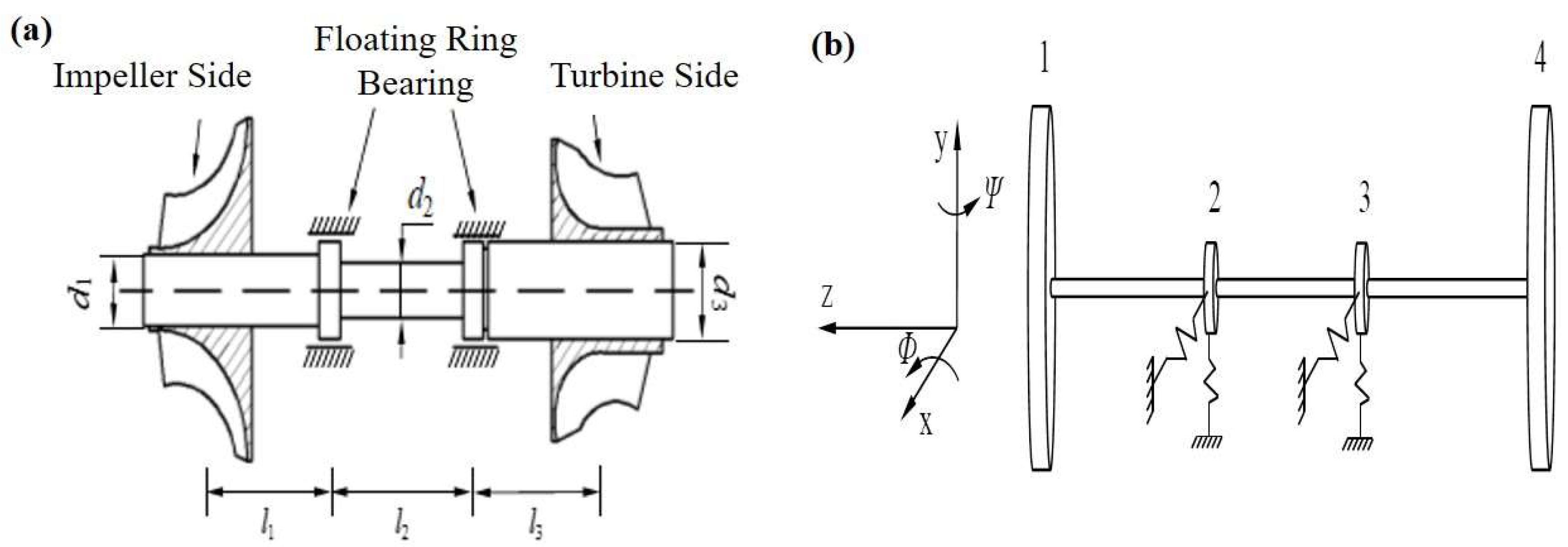

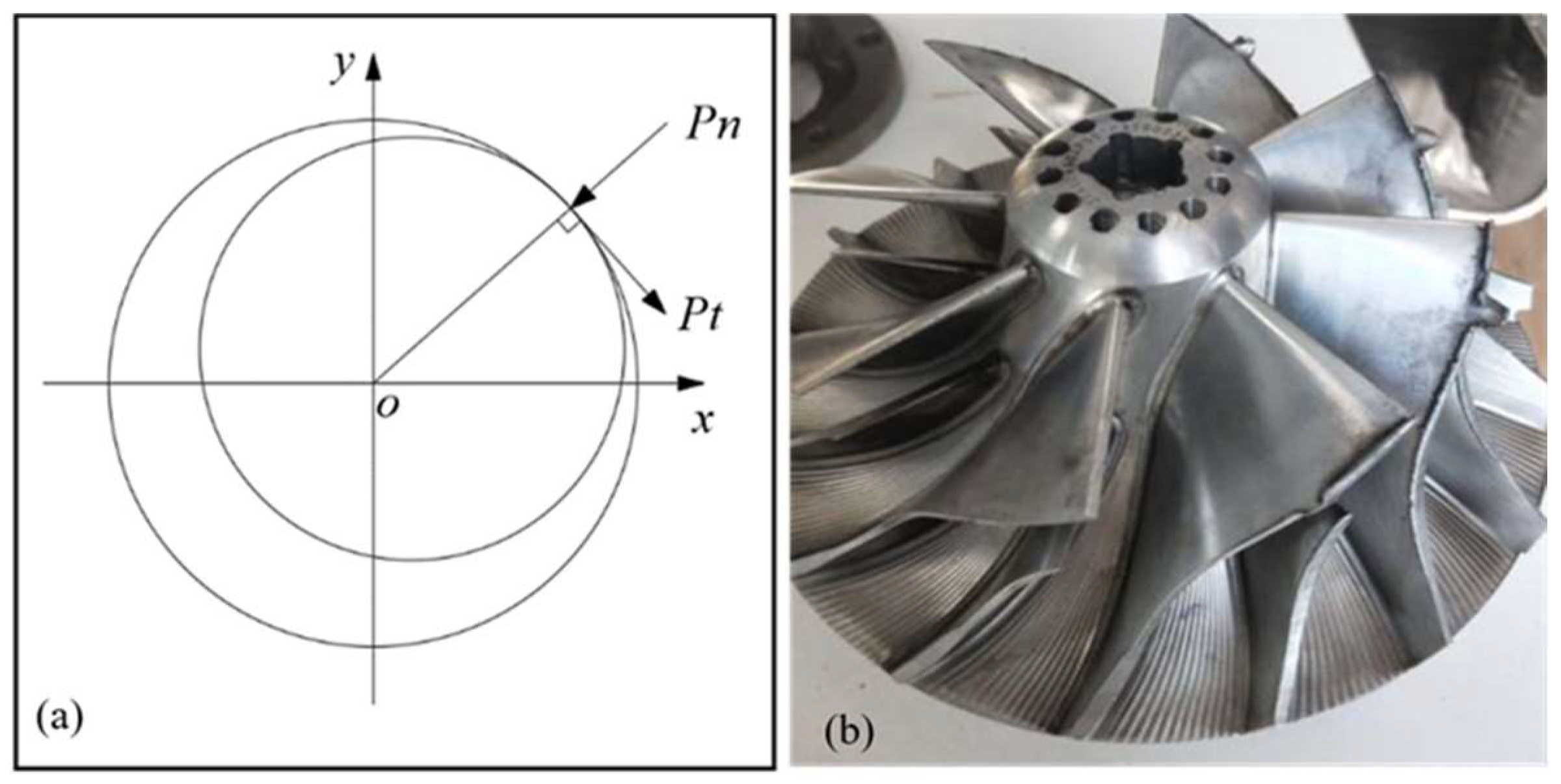
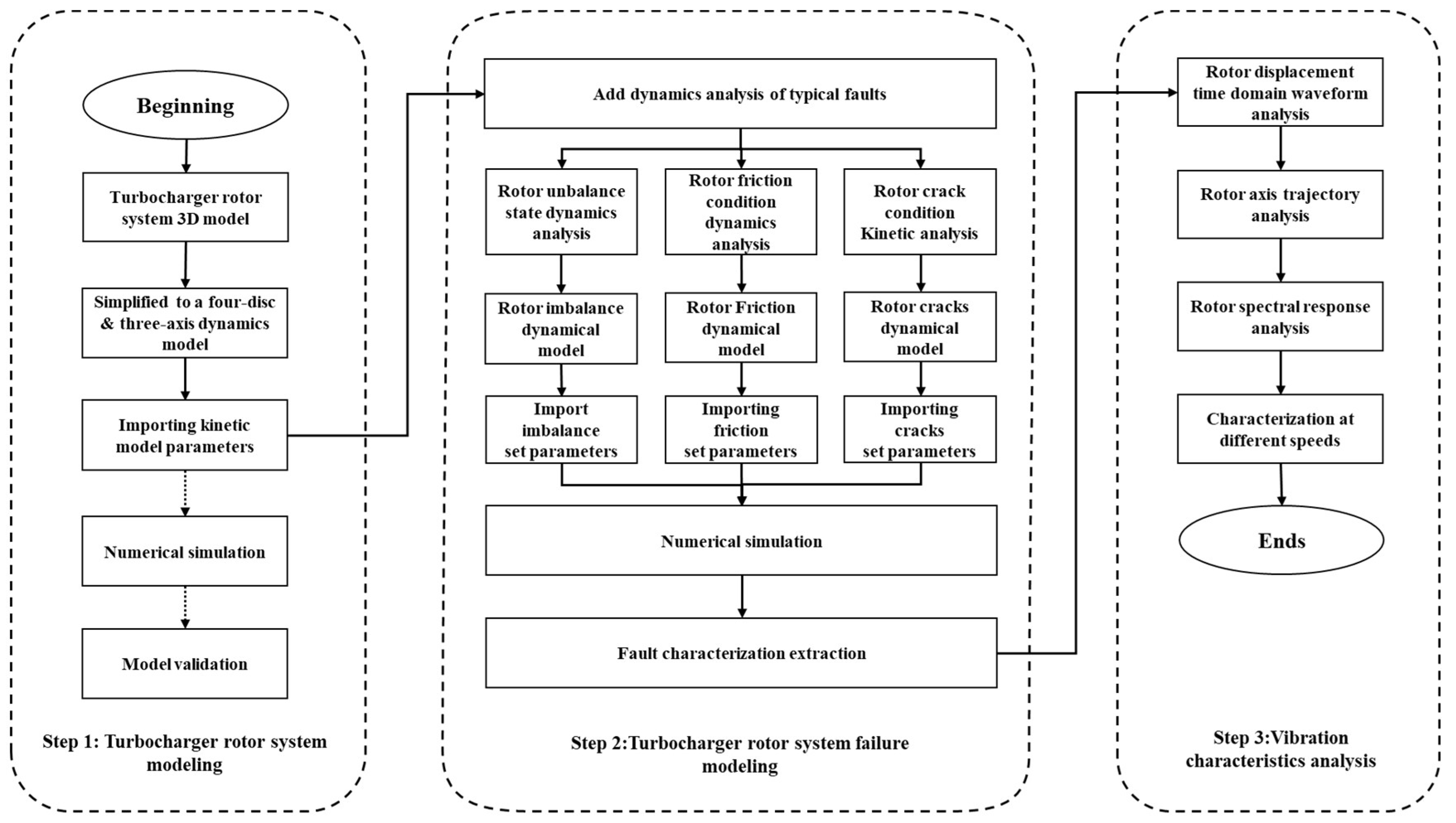


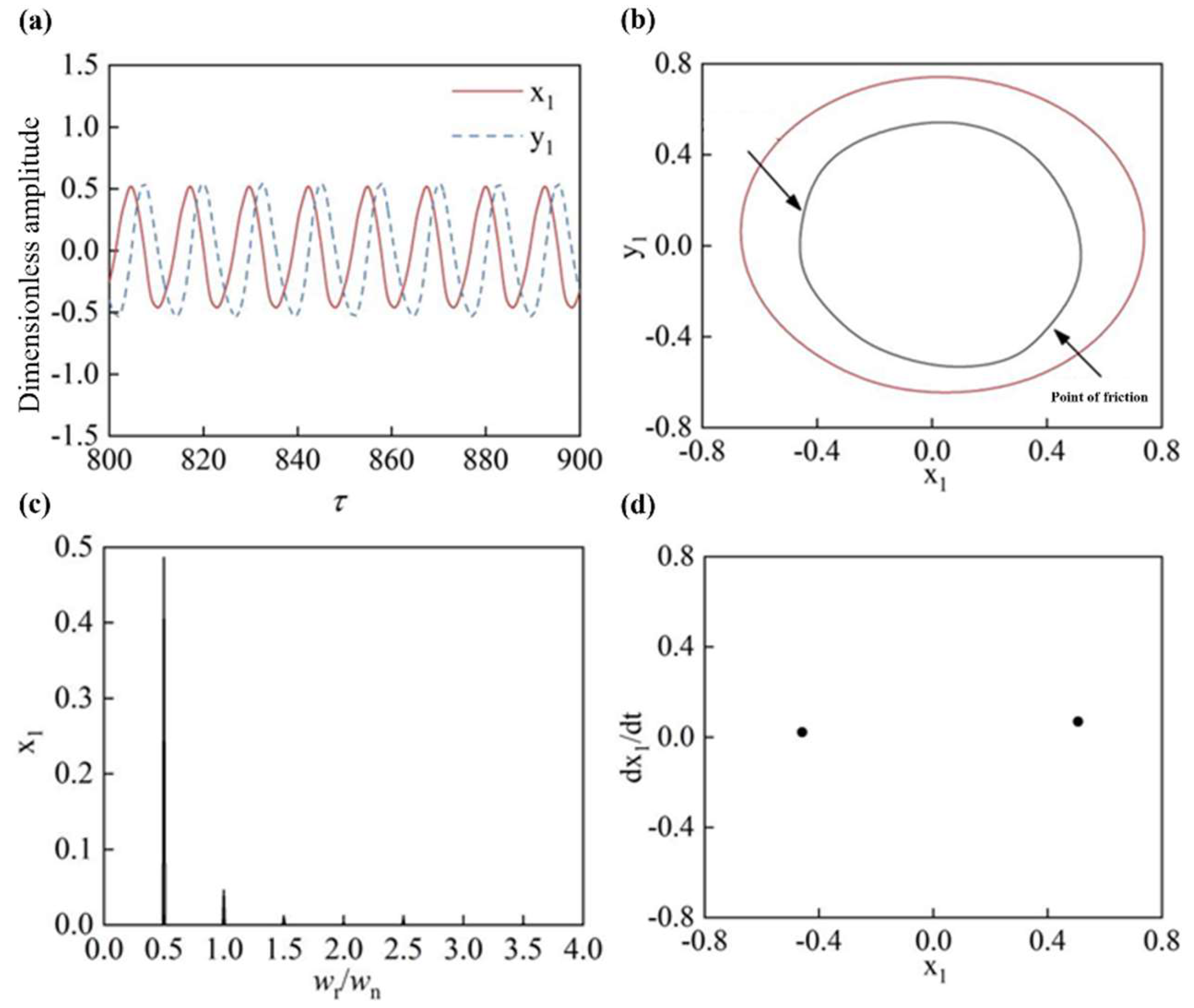
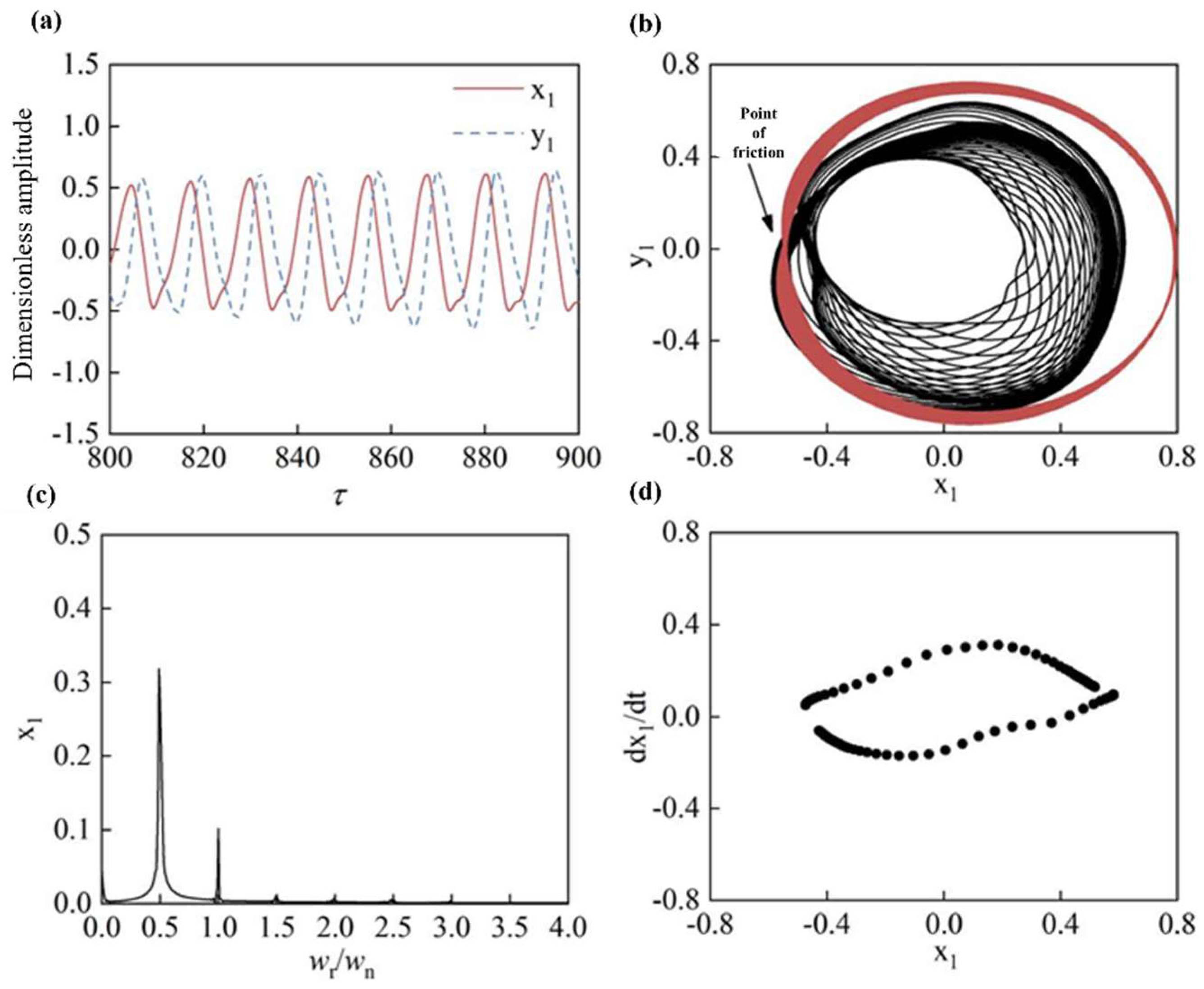
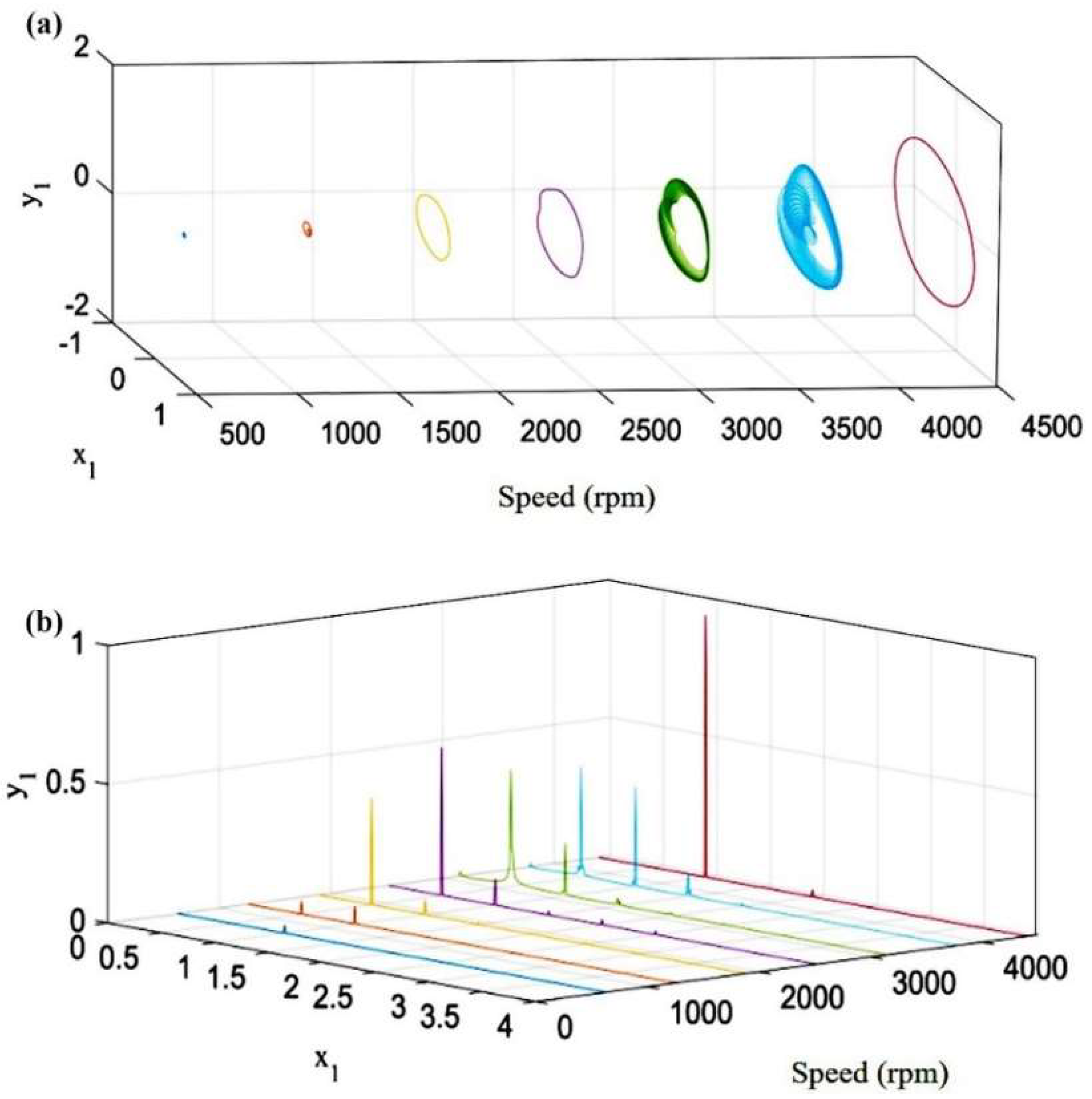
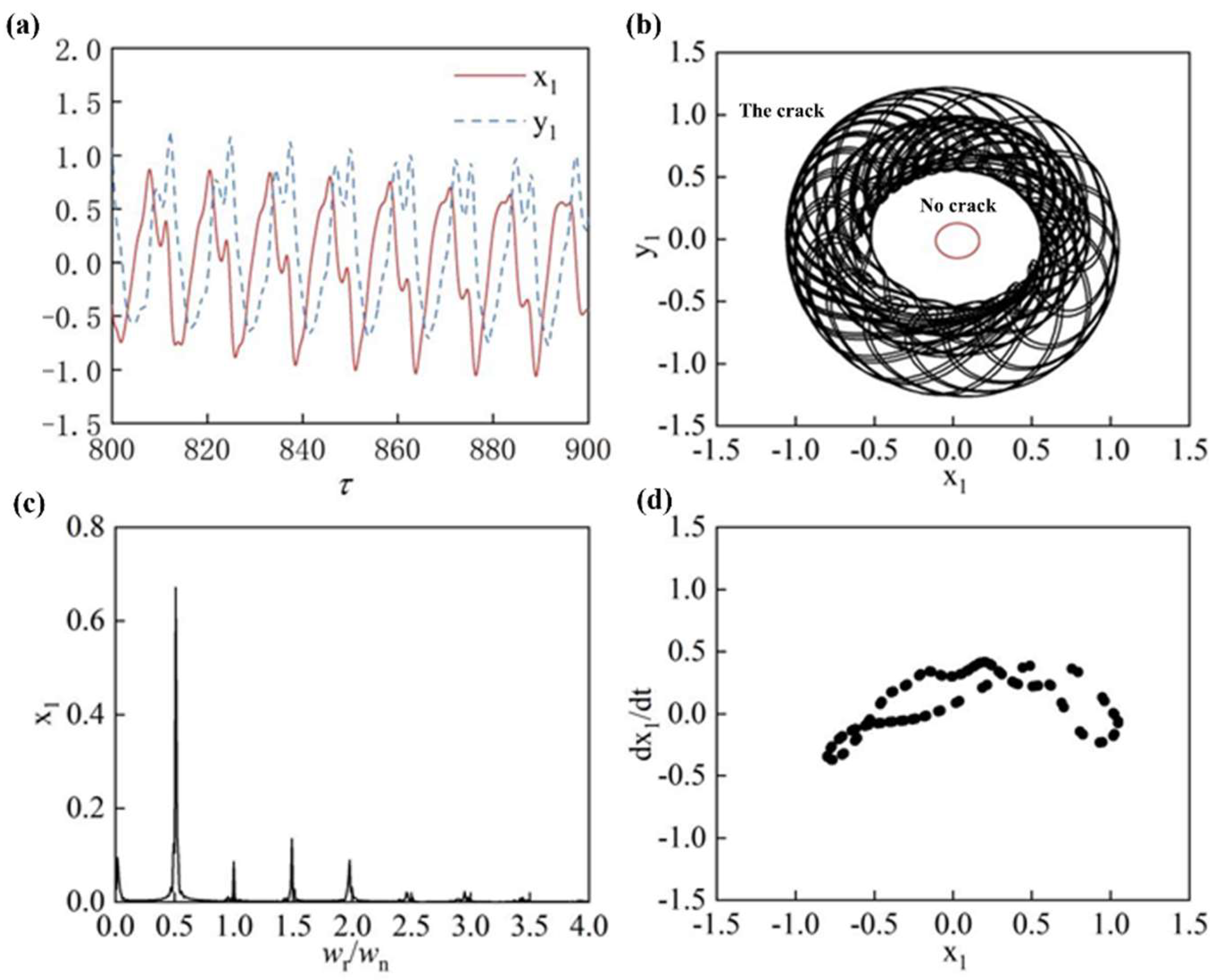
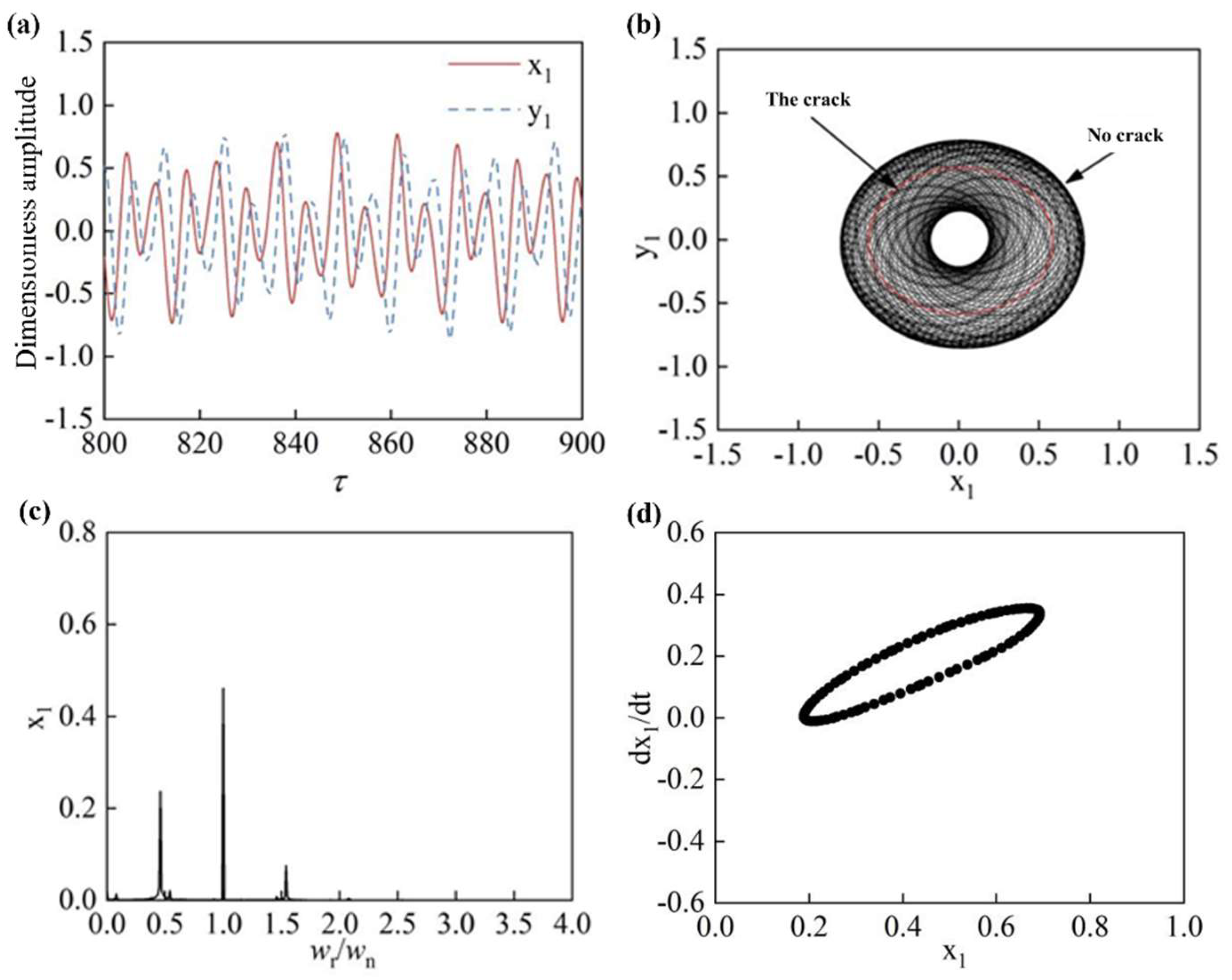

| Physical Parameters | Numerical Value |
|---|---|
| Modulus of elasticity (E) | 2.05 × 1011 Pa |
| Roulette quality | m1 = 5.33 kg, m2 = 0.92 kg m3 = 1.02 kg, m4 = 14.9 kg |
| Rotational inertia | Jd1 = 1.2 × 10−2 kg·m2, Jd2 = 2.05 × 10−4 kg·m2 Jd3 = 1.19 × 10−4 kg·m2, Jd4 = 2 × 10−2 kg·m2 |
| Length of shaft section | l1 = 0.109 m, l2 = 0.094 m, l3 = 0.088 m |
| Shaft section diameter | d1 = 0.038 m, d2 = 0.036 m, d3 = 0.043 m |
| Critical Speed (rpm) | FEM | TMM | Error A (%) | Present Model | Error B (%) |
|---|---|---|---|---|---|
| First backward | 286 | 299 | 4.5 | 281 | 1.7 |
| First forward | 325 | 345 | 6.2 | 324 | 0.3 |
| Second backward | 1004 | 969 | 3.5 | 976 | 2.8 |
| Second forward | 1027 | 997 | 2.9 | 1006 | 2.0 |
Disclaimer/Publisher’s Note: The statements, opinions and data contained in all publications are solely those of the individual author(s) and contributor(s) and not of MDPI and/or the editor(s). MDPI and/or the editor(s) disclaim responsibility for any injury to people or property resulting from any ideas, methods, instructions or products referred to in the content. |
© 2023 by the authors. Licensee MDPI, Basel, Switzerland. This article is an open access article distributed under the terms and conditions of the Creative Commons Attribution (CC BY) license (https://creativecommons.org/licenses/by/4.0/).
Share and Cite
Wang, J.; Wen, H.; Qian, H.; Guo, J.; Zhu, J.; Dong, J.; Shen, H. Typical Fault Modeling and Vibration Characteristics of the Turbocharger Rotor System. Machines 2023, 11, 311. https://doi.org/10.3390/machines11020311
Wang J, Wen H, Qian H, Guo J, Zhu J, Dong J, Shen H. Typical Fault Modeling and Vibration Characteristics of the Turbocharger Rotor System. Machines. 2023; 11(2):311. https://doi.org/10.3390/machines11020311
Chicago/Turabian StyleWang, Jiahao, Huabing Wen, Haiyu Qian, Junhua Guo, Junchao Zhu, Jiwei Dong, and Hua Shen. 2023. "Typical Fault Modeling and Vibration Characteristics of the Turbocharger Rotor System" Machines 11, no. 2: 311. https://doi.org/10.3390/machines11020311
APA StyleWang, J., Wen, H., Qian, H., Guo, J., Zhu, J., Dong, J., & Shen, H. (2023). Typical Fault Modeling and Vibration Characteristics of the Turbocharger Rotor System. Machines, 11(2), 311. https://doi.org/10.3390/machines11020311





